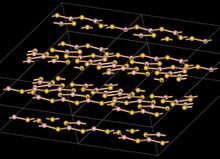Chemistry:Boron sulfide

| |
| Names | |
|---|---|
| IUPAC name
Boron sulfide
| |
| Other names
Boron sesquisulfide, Diboron trisulfide
| |
| Identifiers | |
3D model (JSmol)
|
|
| EC Number |
|
PubChem CID
|
|
| |
| |
| Properties | |
| B2S3 | |
| Molar mass | 117.80 g/mol |
| Appearance | colorless crystals |
| Density | 1.55 g/cm3, solid |
| Melting point | 563 °C (1,045 °F; 836 K) |
| Boiling point | decomposes at high T |
| decomposes | |
| Solubility | soluble in ammonia |
| Structure | |
| monoclinic, mP40, SpaceGroup = P21/c, No. 14 | |
| B: planar, sp2 | |
| Thermochemistry | |
Heat capacity (C)
|
111.7 J/mol K |
Std molar
entropy (S |
327 J/mol K |
Std enthalpy of
formation (ΔfH⦵298) |
-240.6 kJ/mol |
| Hazards | |
| Main hazards | source of H2S |
| Safety data sheet | trc-canada.com |
| GHS pictograms |   
|
| GHS Signal word | Danger |
| H225, H260, H311, H301, H318, H315, H335 | |
| P210, P280, P303+361+353, P231+232, P223, P402+404, P302+352, P312, P305+351+338, P405 | |
| NFPA 704 (fire diamond) | |
| Flash point | 18°C (64.4°F) |
| Related compounds | |
Related compounds
|
BCl3 Lawesson's reagent |
Except where otherwise noted, data are given for materials in their standard state (at 25 °C [77 °F], 100 kPa). | |
| Infobox references | |
Boron sulfide is the chemical compound with the formula B2S3. It is a white, moisture-sensitive solid. It has a polymeric structure. The material has been of interest as a component of "high-tech" glasses and as a reagent for preparing organosulfur compounds.
Reactions
Like the sulfides of silicon and phosphorus, B2S3 reacts with traces of water, including atmospheric moisture to release H2S. This hydrolysis is described by the following idealized equation:
- B
2S
3 + 3 H
2O → B
2O
3 + 3 H
2S
B2S3 readily forms glasses when blended with other sulfides such as P4S10. Such glasses do not absorb mid-frequencies of Infra-red energy relative to conventional borosilicate glasses. Some of these ternary phases that are fast ion conductors.[2]
B2S3 converts ketones into the corresponding thiones. For example, the conversion of benzophenone to its thione proceeds as follows:
- B
2S
3 + 3 (C
6H
5)
2C=O → B
2O
3 + 3 (C
6H
5)
2C=S
In practice, B2S3 would be used in excess.[3]
Synthesis
An early synthesis involved the reaction of iron and manganese borides with hydrogen sulfide at temperatures of 300 °C. The conversion is shown for the monoborides in the following idealized equation:[4]
- 2 FeB + 4 H
2S → B
2S
3 + FeS + 4 H
2
The first synthesis was done by Jöns Jakob Berzelius in 1824 by direct reaction of amorphous boron with sulfur vapor.[5]
- 2 B + 3 S → B2S3
Another synthesis was favoured by Friedrich Wöhler and Henri Etienne Sainte-Claire Deville first published in 1858, starting from boron and hydrogen sulfide.[6]Cite error: Closing </ref> missing for <ref> tag The molecular, monomeric, form of B2S3 has a planar V shape with the central B-S-B angle of approximately 120°.[7]
References
- ↑ Material Safety Data Sheet, VWR, 2010, https://us.vwr.com/assetsvc/asset/en_US/id/8148576/contents, retrieved November 11, 2023
- ↑ Kincs, Joseph; Martin, Steve W. (1996). "Non-Arrhenius Conductivity in Glass: Mobility and Conductivity Saturation Effects". Physical Review Letters 76 (1): 70–73. doi:10.1103/physrevlett.76.70. PMID 10060436. Bibcode: 1996PhRvL..76...70K. https://lib.dr.iastate.edu/mse_pubs/67.
- ↑ Sato, R. (2004). L. Paquette. ed. Encyclopedia of Reagents for Organic Synthesis. New York: J. Wiley & Sons. doi:10.1002/047084289X.rb255. ISBN 0471936235.
- ↑ Hoffmann, J. (1908). "Synthese von Borsulfid aus Ferro- und Manganbor". Zeitschrift für anorganische Chemie 59 (1): 127–135. doi:10.1002/zaac.19080590116. https://zenodo.org/record/1428114.
- ↑ Berzelius, J. (1824). "Undersökning af flusspatssyran och dess märkvärdigaste föreningar". Kongliga Vetenskaps-Academiens Handlingar [Proceedings of the Royal Science Academy] 12: 46–98. https://books.google.com/books?id=pJlPAAAAYAAJ&pg=PA46.
Reprinted in German as:
Berzelius, J. J. (1824). "Untersuchungen über die Flußspathsäure und deren merkwürdigsten Verbindungen". Annalen der Physik und Chemie 78 (10): 113–150. doi:10.1002/andp.18240781002. Bibcode: 1824AnP....78..113B. http://gallica.bnf.fr/ark:/12148/bpt6k150878/f123.image.r=Annalen%20der%20Physic.langEN. see especially pages 145–147. - ↑ Wöhler, F.; Deville, H. E. S.-C. (1858). "Neue Beobachtungen über das Bor und einige seiner Verbindungen". Liebigs Annalen der Chemie und Pharmacie 105 (1): 67–73. doi:10.1002/jlac.18581050109. https://books.google.com/books?id=muE2AAAAYAAJ&pg=PA67.
- ↑ Cite error: Invalid
<ref>tag; no text was provided for refs namedG&E
 |


